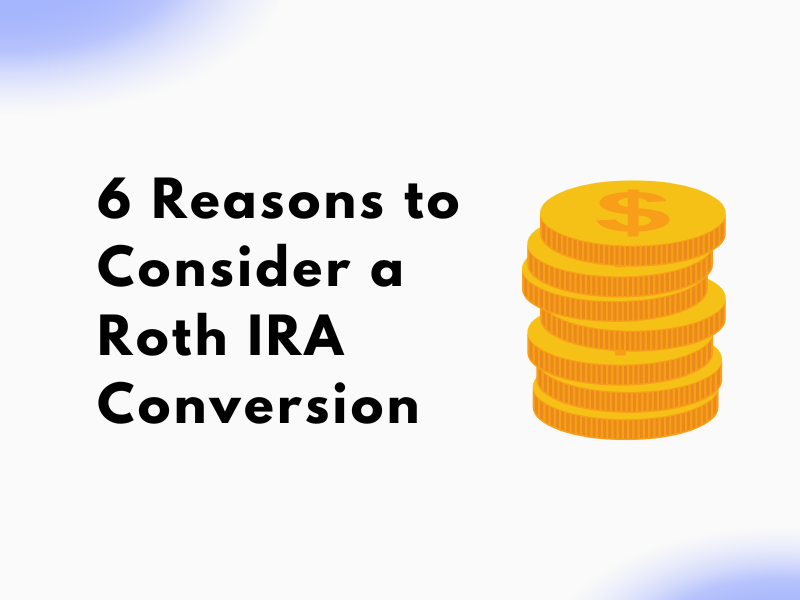A Roth IRA is a great retirement vehicle to consider. There is no tax deduction for contributions, but withdrawals are tax-free. This offers an opportunity for sizable investment gains over the lifetime of the account that will never be taxed.
This contrasts with a traditional IRA, where a tax deduction is available on contributions, but withdrawals are taxed later. While there are income limits for contributing directly to a Roth, there is no income limit to be able to do a Roth IRA conversion. When situations are favorable, you can decide to move all or a portion of your IRA into a Roth IRA, pay taxes on the amount moved and have tax-free withdrawals from the Roth IRA. To get the most benefit, taxes should be paid with cash and not with the IRA funds.
If you would like to discuss how a Roth IRA could beneficial you, feel free to contact me. Here are six reasons why a Roth IRA conversion may make sense.
You Could Be in a Higher Tax Bracket in Retirement
If you expect yourself to be in a higher tax bracket in retirement, a Roth IRA conversion may make sense. It’s an opportunity to be tax-efficient with your retirement funds by paying the tax when your tax bracket is lower.
In many instances, it is difficult to influence your tax bracket. During your working years, your wages strongly dictate where your income bracket falls, and then, in retirement, Social Security and required minimum distributions (RMDs) are recurring payments that impact your tax bracket. RMDs are mandatory minimum withdrawals that must come out of IRAs at age 73.
However, with planning, there is a window of opportunity after retirement and before RMDs start where you may be able to minimize your tax bracket and use those years to do a Roth IRA conversion. Social Security can also be delayed until age 70. If this window is planned for by accumulating cash to pay for retirement expenses, then the tax bracket will be low and a great time for a Roth IRA conversion.
Click here to find out 5 non-financial questions you should answer before retirement.
Roth IRAs Have No Required Minimum Distributions
As mentioned, RMDs are mandatory at age 73 from traditional IRAs. Even if the funds are not needed, they must be withdrawn and will be taxed. This may push you into a higher tax bracket. In addition, failure to take the RMD can result in a 25% penalty, though the penalty drops to 10% if the RMD is withdrawn within two years.
If the IRA is not needed for retirement expenses, many may assume that waiting to make withdrawals is the best strategy since it delays any taxes that are due. However, this may also result in higher RMDs and, therefore, higher taxes due. Roth IRAs do not have RMDs which protects against these potential pitfalls.
Tax Diversification With a Roth IRA
A Roth IRA can be beneficial for tax diversification. That way, you can look at your tax position each year and determine which account would be best to withdraw from when money is needed. For instance, there is an extra charge added to Medicare premiums when income exceeds certain levels. If you find your taxable income nearing one of these levels yet you still need money to meet expenses, pulling the money from a Roth IRA could be an ideal solution. You will receive your funds, meet your expenses and avoid the higher Medicare premiums.
Another common situation that is impacted by income levels is tax due on Social Security income. As your taxable income increases above certain limits, more of your Social Security becomes subject to tax. IRA withdrawals could also result in your income reaching a level where you are impacted by the 3.8% Medicare surtax on investment income.
This surtax would not be due on the IRA withdrawal itself, but it may be added to taxes due on dividends, interest and capital gains because of your IRA withdrawal increasing your income to a point where this surtax now affects you.
Tax diversification is a solution to these problems. By having the Roth IRA, you could avoid crossing the thresholds where these other taxes start.
Estate Planning: Roth IRA Income Not Taxable for Beneficiaries
When Congress passed the SECURE Act in 2019, it changed how non-spouse beneficiaries inherit IRAs. In the past, a non-spouse beneficiary could inherit an IRA and take withdrawals over their life. This helped to spread the tax burden over many years.
With the SECURE Act, those beneficiaries now must liquidate the entire IRA within 10 years. It can be spread out over the years or withdrawn as a lump sum in one of the years, but the result is that there is now a narrower window in which those funds must be withdrawn and taxed.
With less of a window, these larger withdrawals increase the odds of pushing beneficiaries into higher tax brackets. While a Roth IRA would still need to be withdrawn in 10 years, the income is not taxable to your beneficiaries.
Your Tax Filing Status Could Change
As previously mentioned, years in a lower tax bracket are good times to investigate Roth IRA conversions. This is often a result of income levels, but your tax filing status also may be an important factor that could change at some point. Couples with a married filing jointly status recognize higher income at lower rates than other filing statuses.
Death and divorce may cause this to change and push you into higher tax brackets due to a less accommodating filing status.
While no one predicts or wants this to happen, it may be a consideration in some cases, especially for couples with a wide age difference that may not see themselves remarried.
The Market Is Down
When the stock market is down, it may be a good time to do a Roth conversion. You will be able to convert more shares at the lower price and have the potential future gain be tax-free, as it will now be in the Roth IRA. In addition, you can also identify which shares you want to convert if you are doing a partial conversion, selecting the stocks that you think have the most growth potential.
As you can see, there are many reasons to consider a Roth conversion. One important caveat, though, is that each conversion has its own five-year window where you cannot withdraw those funds without a 10% penalty. But if the funds are not needed, the benefits of a conversion can be very strong.
This article was written by and presents the views of our contributing adviser, not the Kiplinger editorial staff. You can check adviser records with the SEC or with FINRA.Kevin Webb is a financial adviser, insurance professional and Certified Financial Planner™ at Kehoe Financial Advisors in Cincinnati. Webb works with individuals and small businesses, offering comprehensive financial planning, including Social Security strategies, along with tax, retirement, investment and estate advice. He is a fiduciary, ensuring that he acts in his clients’ best interests.



